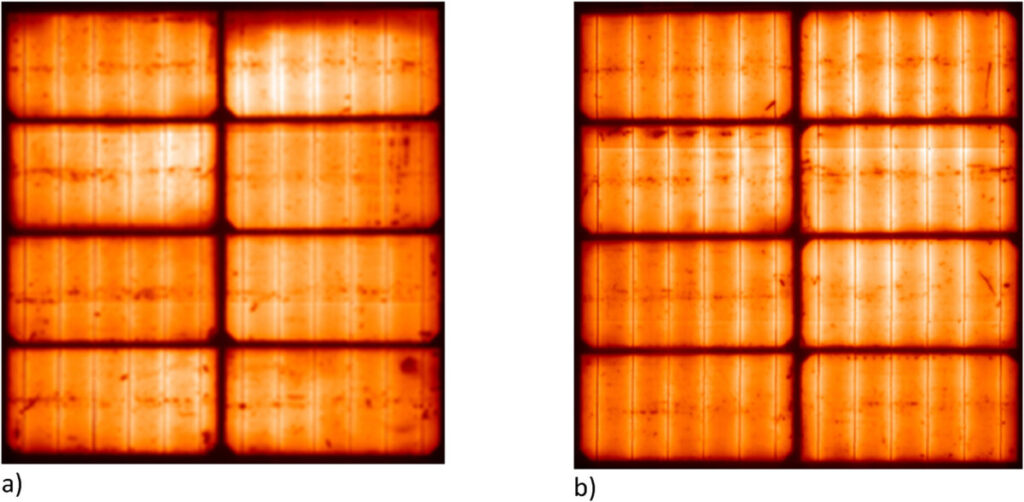The French research institute showed that switching from silver cell metallization to the metallization of Zilverkopper can lower the total silver quantity in a heterojunction module, with a total silver quantity of only 14 mgag/w required. Their interconnection technique is based on a low silver content of electrically conductive adhesives and copper ribbons.
Researchers from the French National Solar Energy Institute (Ines) – a division of the French alternative energies and Atomic Energy Commission (CEA) – have developed a new PV module interconnection technology based on the use of electric conductive adhesives (ECA) with minimal silver (AG) content, copper (CU) ribbons and an AG-CU metallization paste.
“We have evaluated three different ECA formulations that guarantee their compatibility with ribbon coated by various conductive materials such as AG, Bare CU and tin mixed with silver,” said the main author of the research, Rémi Monna, said PV -Magazine. “We have found that low-silver ECAs can perform better than the ECAs of the previous generation that demonstrate higher performance and reliability.”
In the study “Use of CU ribbons and CU-AG HJT Celmetallization on ECA-based interconnection for PV modules“Published in Solar energy materials and solar cellsMonna and his colleagues explained that their tests were performed on a rear junction hetero junction (HJT) solar cell based on an M2 N-type Czochralski waffle and mini modules with 8 half cells that were manufactured using polyolefin elastomeer (Poe) insapsulant.
The cell layers were deposited via stencil print technology instead of screenshot technology. The first was chosen because of the benefits it offers for the reproducibility of the deposit over time, the researchers said. The modules were tested according to the IEC 61215 -Standard in moisture heat (DH) and thermal cycles (TC) aging
“Electric parameters are measured after 100, 200, 400 and 600 TC with a specific focus on the filling factor of the module and electroluminescence image formation to reveal possible series resistance and interconnection figures,” the paper notes. “The pilot test is used to qualify the adhesion of Interconnect ribbons to solar cell metallization.”
The analysis showed that on silver-based metallized cells and modules demolished under 2 % after 3000 hours of DH, while in copper-based cells moisture breakdown after 2000 hours, a value that the academics described as “comparable” with those of modules with full silver metallized cells.
In addition, the scientists found that switch from AG-Celmetallization to AG-CU metallization reduced the total silver quantity in the module, with a total silver quantity of 14 mgag/w. They have also established that silver use can be reduced by a maximum of 26% when ECAs with a low AG content are used in combination with bare CU ribbons.
“We have carried out a first, provisional cost analysis. A more detailed study must still be carried out in collaboration with our partners, taking into account the product characteristics, the planned production volumes and other specific characteristics of the industrial lines,” explained Monna. “The implementation of this innovation requires joint work with equipment manufacturers, in particular for the screenshot and interconnection phases, as well as with material suppliers. The vast majority of these partners are located in Europe, which is an asset.”
Monna also stated that Ines is currently planning to test this innovation in real production lines. “We work closely with 3Sun on problems with regard to reducing the use of silver in modules,” he said. “Moreover, some of the innovations that we develop can also be transferred to other cell technologies and are therefore potentially interesting for other manufacturers.”
In January, the heterojunction based in Ines and Italy achieved solar module manufacturer 3sun, a unit of Enel, a power conversion-efficiency of 30.8% for a two-term tandem perovskiet-silicon solar cell.
They also jointly developed DC/DC-Maximal Power Point Trackers (MPPT) and in March 2022 achieved a power conversion rating of 24.47% for a Gallium-mottled P-Type Heterojunction Silicon Silicon Solar Cell.
This content is protected by copyright and may not be reused. If you want to work with us and reuse part of our content, please contact: editors@pv-magazine.com.

